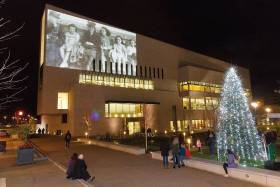Displaying items by tag: People on the Pier
#PeopleOnPier - Due to popular demand DLR Libraries “People on the Pier” exhibition has been extended giving the public the opportunity to view the free photographic indoor event.
Afloat had reported of the exhibition launched earlier this month which involved an open-air display of peoples photos beamed onto the outside of the Lexicon Library. These publically contributed images formed the current indoor exhibition on display in the iconic building.
In total the collection of 400 candid photos were taken over the years of families and friends enjoying the pier, which were submitted as part of the 2017 commemorations for the bicentenary of Dun Laoghaire Harbour.
The display in the Lexicon Library's Lab will also serve the purpose of keeping the dlr Libraries’ Local Studies Collection current. The exhibition continues this week but is only to remain running until 5pm this Saturday 16 December.
Today, this Thursday up to 8 pm
Fri / Sat – 9.30 am – 5 pm
For further details of the People on the Pier project and more click the link here.
Join in to Celebrate 'People On the Pier' Photos to Mark Bicentenary of Dun Laoghaire Harbour
#CelebratePiers – Tomorrow evening, Wednesday 6 December, is a time to celebrate and join in the People on the Pier photo exhibition as part of events for the 200th anniversary of Dún Laoghaire Harbour in 2017.
Over the many years, millions of people have strolled down Dun Laoghaire’s beloved embracing harbour arms of the East and West Piers and many more will continue to step onto the granite built structures protruding into Dublin Bay. It is from the pierheads where you are rewarded the most with wonderful commanding views of both sea and land coupled with countless memories.
A selection of these People on the Pier photos will be projected on the outside of the dlr LexIcon Library from tomorrow at 6.45pm. The exhibition marks the culmination of dlr Libraries’ Bicentenary of the Harbour celebrations and is a project which will have a lasting legacy for the borough's local history collection.
All are welcome to attend the free event and celebrate with mulled wine and mince pies!
The People of the Pier project which began earlier this year was created by the Local Studies department of DLR Libraries and is based on a Humans of New York-style project, that showcases photos of the many people who walk along Dun Laoghaire Pier every Sunday.
Over the last year, the project had invited people to take photos of themselves walking the two piers (plus some older photos). The public were then asked to submit their photos by posting them on social media.
For more information of other events organised by Dun Laoghaire-Rathedown County Council click here.





























































